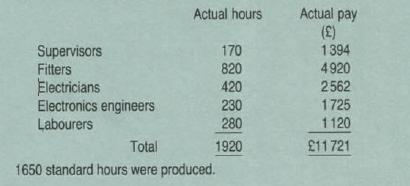Intermediate: Labour mix and yield variances A large manufactunng company w1th a diverse range of products is
Question:
Intermediate: Labour mix and yield variances A large manufactunng company w1th a diverse range of products is developing the use of standard costing throughout its divisions. A full standard costing system has already been implemented in Division A, including the use of mix and yield material variances, and attention has now turned to Division B where the main problem concerns labour.
Division B makes highly complex work stations which incorporate material handling, automatic controls and robotics.
Manufacture is a team effort and the team specified for work station No. 26 comprises 2 supervisors paid £8 per hour 10 fitters paid £6 per hour 6 electricians paid £6 per hour 2 electronics engmeers paid £7 per hour 4 labourers paid £4 per hour Output is measured in standard hours and 90 standard hours are expected for every 100 clock hours. During a period the following data were recorded .

The factory director of Division B is anxious to gain the maximum information possible from the standard costing system. He sees no reason why the normal labour efficiency variance could not be divided into sub-variances in order to show separately the effects of non-standard team composition and team productivity in a similar fashion to the material usage variance which can be sub-divided into mix and yield variances You are required
(a) to calculate the labour rate variance; (3 marks)
(b) to calculate (i) the team composition variance, (ii) the team productivity variance and (iii) labour efficiency variance; (11 marks)
(c) to comment on the meaning of the variances calculated in
(b) and their weaknesses.
Step by Step Answer:







